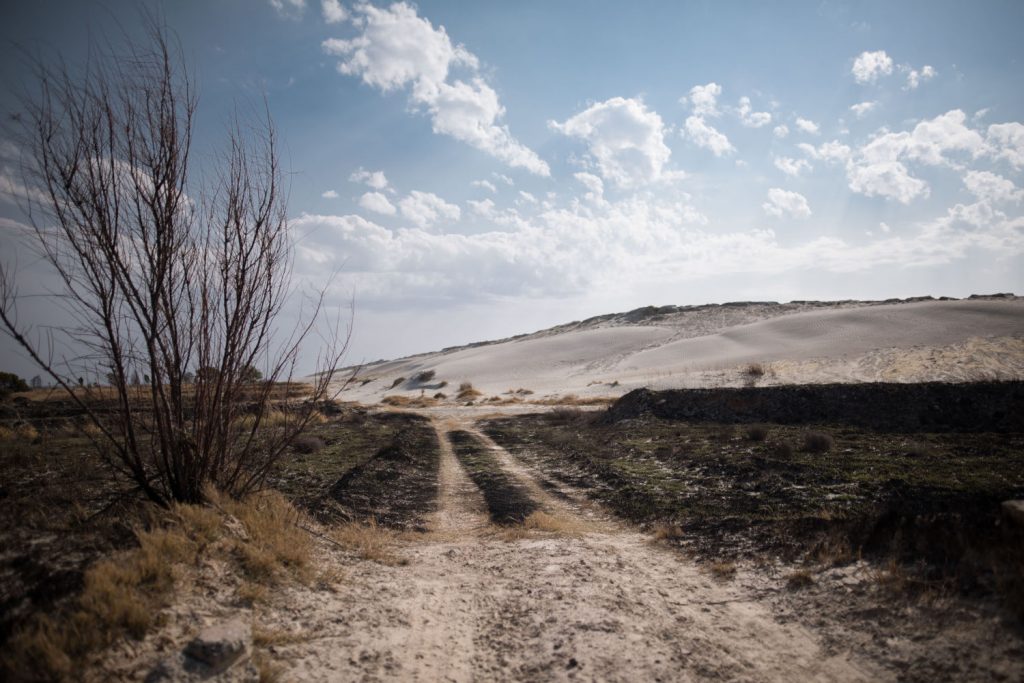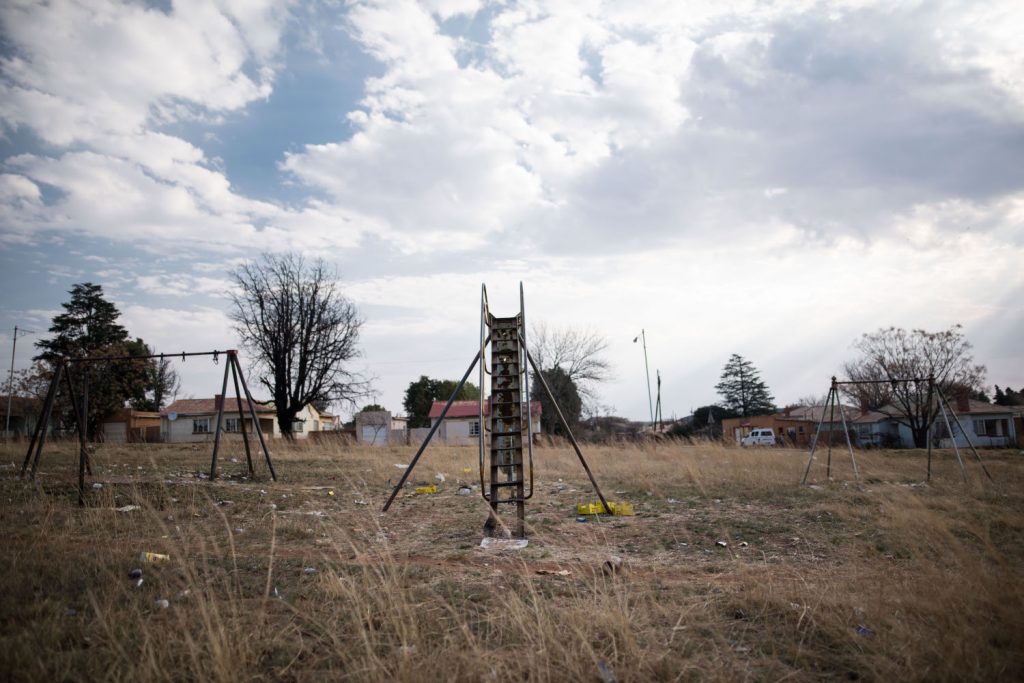Mining companies often abandon their operations with little or no concern for the communities left behind.
Colonial and apartheid-era policies and practices modelled the exploitative and exclusive nature of mining in South Africa, a legacy that continues to shape the economic, social, and legal landscape of the present-day mining industry.
Various accounts from mining-affected community members, as captured in Lawyers for Human Rights (LHR) and Rosa Luxemburg Stiftung’s 2022 report The Impact and Assessment of Improper Mine Closures in South Africa: Community Perspectives on Human Rights, reveal the demographic and socioeconomic landscape that evolved from apartheid spatial planning and a mining legacy that remains largely unchanged.
 Mining affected communities ultimately shoulder the burdens associated with mining and improper mine closure.
Mining affected communities ultimately shoulder the burdens associated with mining and improper mine closure.
Mining-affected communities have expressed concerns regarding the devastating environmental and social impact that mining has had on their wellbeing and livelihoods, particularly during mine closures. While the post-apartheid government has taken legislative measures to regulate mining operations and transform the industry, the lived reality for many residents of mining-affected communities is that this has done little to effectively transform and offset the harmful impact of mining on their daily lives.
Communities hold the view that the devastating impact of mining and continued inequality is perpetuated through the impropriety of national and transnational corporations as well as the lack of state oversight — wilful or negligent — on their activities.
An examination into the state and impact of improper mine closures in South Africa and understanding communities’ perspectives allowed LHR to assess the true human cost of mining projects in South Africa. Black communities are being left in the dust as mining companies continue to extract the riches from the land that these communities use.
The adoption of legislative measures such as the Mineral and Petroleum Resources Development Act (MPRDA) in 2002 was an important step in addressing inequality within the mining industry. In recognition that the mineral resources of South Africa are the common heritage of all those who live here, the MPRDA requires a mine to include in its application to mine a Social and Labour Plan (SLP), which must detail how a mine plans to benefit the community. SLPs are a legally binding mechanism through which companies are required to promote employment, advance social and economic welfare, and contribute to the development of the community within which they operate.
However, due to lack of consultation with host communities regarding the type of development they would like to benefit from and a failure to fulfil the undertakings made in SLPs, many mining communities continue to live in extreme poverty. LHR’s research shows that notwithstanding the precarious socioeconomic conditions during mining, these conditions drastically decline at the point of mine closure when the main sources of economic activity — mining, and the local economies dependent on mining — stop.
 Due to large quantities of waste in mine dumps, communities are exposed to dangerous levels of heavy metals.
Due to large quantities of waste in mine dumps, communities are exposed to dangerous levels of heavy metals.
Inequality continues to be a distinctive feature of mining in South Africa, and there has been an increase in mining companies avoiding their obligations during and post mining. Host communities have expressed concern regarding the lack of regulatory oversight by the Department of Mineral Resources and Energy (DMRE), particularly at the point of mine closure. Research shows that despite formal legislative processes and requirements for mine closures, corporate impunity and poor state regulation has resulted in continued improper closures or the abandonment of mines, creating long-standing environmental, economic and social difficulties for mining-affected communities.
Instead of formally closing the mine, many mining companies suspend operations under the guise of temporary care and maintenance and continue renewing the temporary suspension for many years, or indefinitely. Alternatively, mines are sold to small companies that do not have the necessary resources to ensure that the mine closure is implemented responsibly and in compliance with the law. In some cases, the mines are simply abandoned by the company.
At improperly closed mines the mine shafts and pits are often left open and sometimes are not even fenced off, and this is further invariably associated with the failure to maintain and mitigate the adverse impacts of mining waste such as tailing dams and waste rock dumps. In its 2017 study of four communities in Soweto, non-governmental research and advocacy organisation the Bench Marks Foundation emphasised that due to large quantities of waste in mine dumps, communities are exposed to dangerous levels of heavy metals such as silica, zinc, lead and copper. These metals are considered responsible for many of the health complications that affected communities experience, including kidney, neurological, cardiovascular and respiratory related illnesses.
The Council of Geoscience indicated that as of 2016, South Africa had 6 000 “derelict and ownerless” mines. Although the DMRE has apparently made attempts to mitigate the harmful impacts of improper mine closures, particularly for asbestos mines, it is unclear what exactly the department has done to address the challenges associated with the 6 000 derelict and ownerless mines, and improper mine closures more broadly.
In the absence of adequate regulation and legislative compliance, mining affected communities ultimately shoulder the burdens associated with mining and improper mine closure, including public safety, health, environmental and socioeconomic injustices.
 The Social and Labour Plan must detail how a mine plans to benefit the community living next to it.
The Social and Labour Plan must detail how a mine plans to benefit the community living next to it.
The reality is that the abandonment of mines has become synonymous with the abandonment of mining communities and moreover, the social responsibilities towards these communities. With continued regulatory failure, the relationship between the livelihood of communities and mining activities is linked in a manner that creates a power imbalance where host communities become dependent on the mine for economic survival. Therefore, when mines close or are put onto indefinite care and maintenance, there are monumental impacts on the livelihoods of mining communities. It is in this light that it becomes imperative that we think about what the progressive realisation, protection of rights, and sustainable post-mining community looks like, and what is needed to achieve this.
Effective mine closures require proper planning throughout the lifecycle of the mine and not just towards the end of a mine’s lifespan. There should be greater regulatory oversight and community consultation at every stage of mining, including mine closure. Mining companies must take responsibility for their practices and impact on communities.
A common thread throughout South Africa’s mining history has been inequality. We must cut this thread and ensure that visions of mining justice are based on shared prosperity. This is only possible through meaningful and actual community participation in all decision-making processes throughout the lifecycle of a mine, in the ownership of mines, and in the strengthening of the legislative framework and regulations to combat widespread abuse of current loopholes in the law that facilitate the dereliction of mines and exploitation of communities. Above all, communities ought to have the right to decide on the type of development they want to benefit from. — Palesa Maloisane